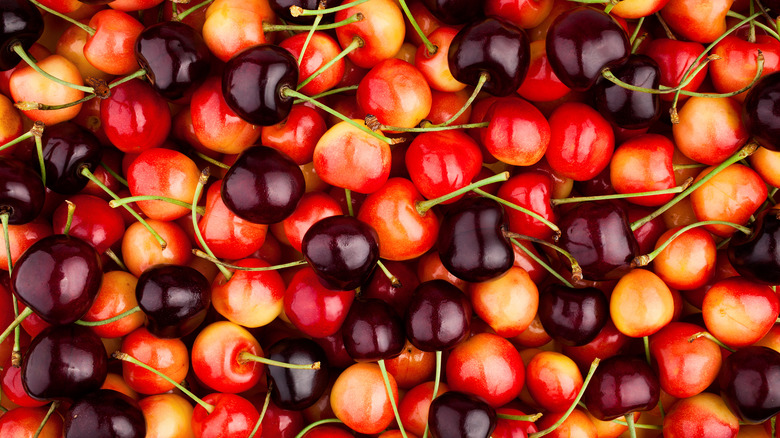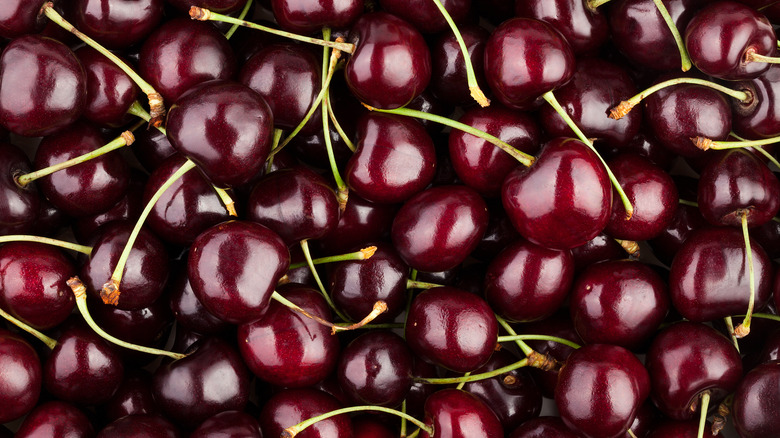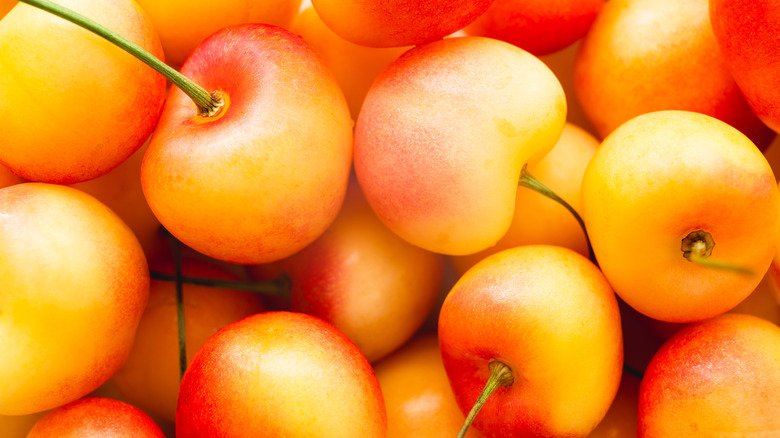What's The Difference Between Bing Cherries And Rainier Cherries?
In the United States, fresh sweet cherries are a summer decadence. The love for cherries may have a long past, since eating them possibly pre-dates known human history (via Washington State Fruit). Cherry pits have been discovered in many European Stone Age-era caves. So as you enjoy this summer fruit, you are partaking in an ages-long global tradition.
According to Washington State Magazine, many think that cherries originated between Eastern Europe and Asia in the regions around the Black and Caspian Seas. The first written mention of cherries is a the 3rd century B.C.E Greek book called, "The History of Plants." The Greeks are thought to have first cultivated cherries as crops. Later, European colonizers then brought the cherries to the Americas.
Now, Washington State produces the most sweet cherries in the United States. The Pacific Northwest is home to two of the most popular sweet cherry varieties: the Bing and the Rainier cherries. While the two types of cherries are equally delicious, they have a notable difference that may affect which you choose to add to your table, recipe, or garden.
The Bing Cherry
Bing and Rainier cherries do share some basic similarities. First, they are sweet cherries and both are undeniably tasty. This likeness may be because they both literally stemmed from the same source, the sweet cherry tree (Prunus avium). The sweet cherry tree is sometimes called a bird cherry since the tree attracts many birds, reports SF Gate. Because of their appealing taste to many species, growers must be especially mindful of protecting the trees from hungry critters.
Bing cherries stand out as the most widely-known cherry in the United States, according to Northwest Cherry Growers. They're identified by their characteristic heart shape, maroon, near-black skin, and dark purple insides (via SF Gate and This Old House). Bing cherries are especially popular for several reasons. First, these cherries are large and have a flavor that's satisfyingly both sweet and tart, writes Specialty Produce. Additionally, Bing cherries are excellent for baking and preservation since the cherry stones are somewhat loose and easy to remove, states Arbor Day. Bing cherries also have firm skin, which makes them easy to ship, per Oregon Encyclopedia.
One of the other reasons for the fruit's popularity is that Bing cherries are versatile (via California Fruit Gifts). You can eat them fresh, cooked, preserved, or frozen. This multi-use cherry is an excellent choice for summer cooking and baking.
The Rainier Cherry
Rainier cherries have a striking yellow and blush pink color, writes SF Gate. Their insides are a unique yellow, and the fruit is known for its big and plump size, explains Northwest Cherry Growers. Rainier cherries are much sweeter than Bing cherries. Washington State University (WSU) horticulturist Matthew Whiting calls them "tree candy" (via Washington State Magazine).
While uncontended in their taste, Rainier cherries are finicky and more challenging to raise. They have a shorter blooming season than Bing Cherries; only six-seven weeks. They're also more vulnerable to extreme temperatures, more delicate, and bruise easily. Furthermore, each season, birds eat as much as one-third of the Rainier cherry crop grown, reports National Day Calendar. Because of the difficulties raising them, Rainier cherries typically run a little pricier, states Washington State Magazine. That said, many may pay the extra price for the sweet candy-like fruit. Delicious on their own, Rainier cherries are best enjoyed fresh. You can use them as ingredients in salads, cocktails, or desserts.
Both the Bing and Rainier cherries have enthusiastic fans. Truly the choice between the two is a win-win; each is delicious. Either one will infuse your meal, table, or snack with some peak-summer sweetness.


